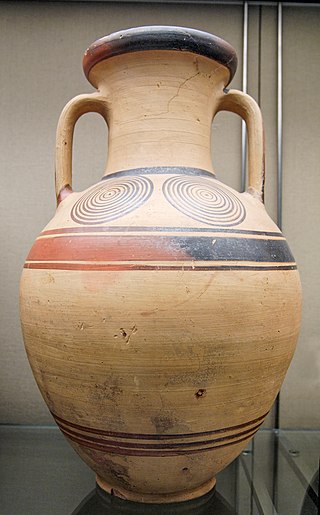Top Qs
Timeline
Chat
Perspective
Protogeometric style
Type or style of Ancient Greek ceramic From Wikipedia, the free encyclopedia
Remove ads
The Protogeometric style (or Proto-Geometric) is a style of Ancient Greek pottery led by Athens and produced, in Attica and Central Greece, between roughly 1025 and 900 BCE,[1][2][3] during the Greek Dark Ages.[4] It was succeeded by the Early Geometric period.


Earlier studies considered the beginning of this style around 1050 BCE.[5][6]
Remove ads
History
After the collapse of the Mycenaean-Minoan Palace culture and the ensuing Greek Dark Ages, the Protogeometric style emerged around the late 11th century BCE,[1] as the first expression of a reviving civilization. Following on from the development of a faster potter's wheel, vases of this period are markedly more technically accomplished than earlier Dark Age examples. From Athens the style spread to several other centres.[7]
Remove ads
Production and decoration
The decoration of these pots is restricted to purely abstract elements and very often includes broad horizontal bands about the neck and belly and concentric circles applied with compass and multiple brush. Many other simple motifs can be found, but unlike many pieces in the following Geometric style, typically much of the surface is left plain.[8]
Like many pieces, the example illustrated includes a colour change in the main band, arising from a firing fault. Both the red and black colour use the same clay, differently levigated and fired. As the Greeks learnt to control this variation, the path to their distinctive three-phase firing technique opened.
Some of the innovations included some new Mycenean influenced shapes, such as the belly-handled amphora, the neck handled amphora, the krater, and the lekythos. Attic artists redesigned these vessels using the fast wheel to increase the height and therefore the area available for decoration.
Remove ads
Chronology
Based on radiocarbon datings and Bayesian models to Lefkandi, Kalapodi and Corinth, Toffolo et al. (2013) placed the Sub-Mycenaean/Protogeometric transition "in the second half of the 11th century, approximately centered on 1025 BCE."[9]
Alex Knodell, in his (2021) book, classifies Protogeometric period in three sub-periods:[10]
See also
References
Sources
Further reading
External links
Wikiwand - on
Seamless Wikipedia browsing. On steroids.
Remove ads
